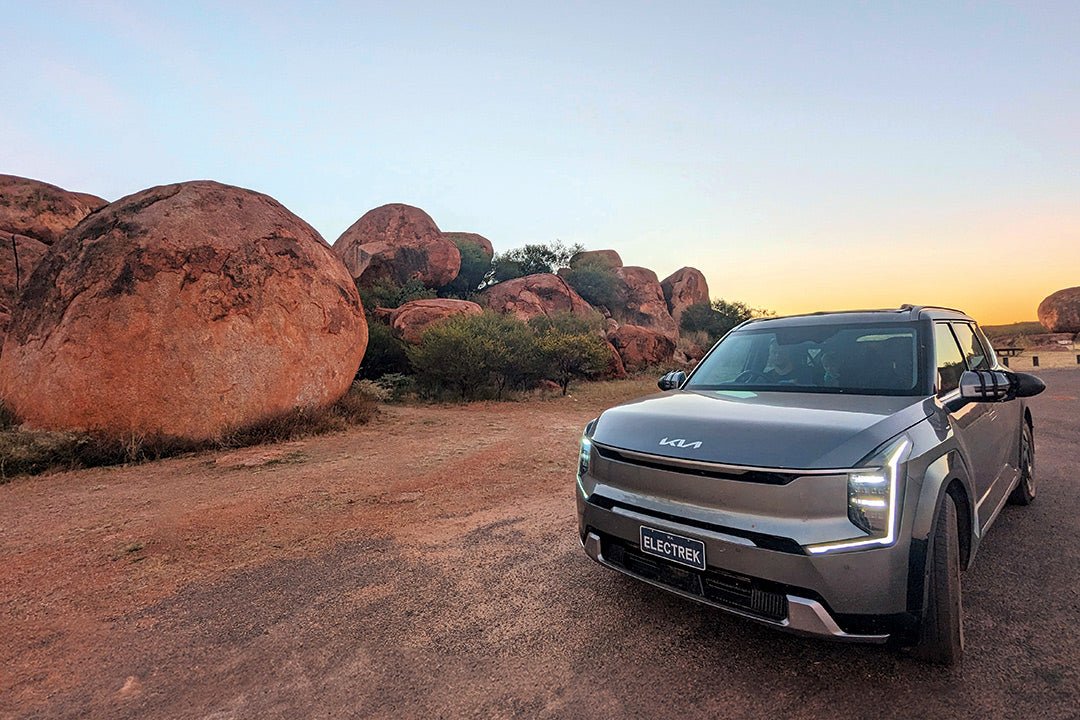

The McLennans cross the border from WA to discover that the NT lags behind in fast-charging infrastructure for electric vehicles.
Crossing into the Northern Territory (NT), the road conditions immediately revealed their rugged nature, with patches, potholes and ruts even on major routes fitting the Territory’s wild reputation.
While Western Australia has nearly completed the initial rollout of its EV Network, the Northern Territory lags with significantly fewer fast-charging options. However, this is changing rapidly thanks to a partnership between the Federal Government and NRMA to deliver a national EV fast-charging network, including 16 locations throughout the NT.
Our first stop in the Territory was Victoria River, where we trickle-charged the Kia EV overnight while camping. Until the fast-charging network progresses, there are no other charging options along the stretch from the WA border to Katherine. Initially, we faced some issues with the power dropping out until we discovered a 10A breaker on a 15A outlet. Switching to a different outlet with the correct breaker solved the problem. We enjoyed a great campsite by the river, slung up the hammock, and topped up the battery to 100 per cent while we slept.

NRMA Fast Charger in Katherine
A conveniently located 175kW fast charger at Katherine made exploring the region in an EV incredibly easy and, conveniently, charging took the exact amount of time as our grocery run. Nitmiluk National Park’s Leliyn (Edith Falls) and Katherine Hot Springs were family favourites in the area.
Next, we visited Litchfield National Park, where beautiful weather complemented our exploration of the national park. Although there are no fast chargers in the area, trickle charging overnight from a standard outlet powered by the campsite’s solar array provided enough clean energy to explore all the park’s attractions.

The Cascades, Litchfield National Park
In Darwin, we found plenty of fast-charging station options but didn’t use any, as the top-up from our powered campsite each night kept our battery full without additional energy costs. We received a warm welcome from the NT EV Association, which was eager to learn from our experience. We were also delighted to be invited to visit a local primary school whose students were studying the future of transport and had been following our adventures.
A visit to UNESCO World Heritage-listed Kakadu National Park was a highlight, featuring an Indigenous ranger tour of Ubirr with its ancient rock art and stunning sunset views, and the Yellow Water cruise showcasing abundant birdlife and massive saltwater crocodiles.
We stayed in Jabiru, where the Australian Electric Vehicle Association (AEVA) has installed a three-phase outlet in the campgrounds, ensuring a full battery each morning at no extra cost. Jabiru is now powered by the Hybrid Renewable Energy plant, drawing 100 per cent solar power during the day, with the battery kicking in come evening and the diesel only there as a backup.
Mataranka’s Bitter Springs and thermal pools were a hit with the kids, who loved drifting down the warm, crystal-clear stream and swimming back against the current. The Nathan ‘Whippy’ Griggs show delighted everyone with unique and impressive whip skills, and both kids wanted their own whips afterwards!
Further south, we noticed our energy consumption was unusually high and our range low, only to discover ‘someone’ had forgotten to release the handbrake on the camper. The unexpected drain on our battery meant we might not have the range to reach our next destination, but fortunately, an old three-phase outlet at the Elliott Roadhouse, provided by the AEVA gave us the top-up we needed during an extended lunch stop. Elliott is set to become one of the fast-charger locations as part of the EV Network rollout.

AEVA Charging Point, Tennant Creek
Similarly, Tennant Creek is also set to receive a fast charger. Meanwhile, we used another three-phase outlet provided by the AEVA to charge overnight before heading to Karlu Karlu (Devils Marbles). We then continued our adventure into outback Queensland.

Elliott and Xavier at Karlu Karlu (Devils Marbles)
The number of solar farms along our route, making use of the abundant space and sunshine to power remote NT communities, was a pleasant surprise. Hopefully the NT government addresses its issues with allowing connection to the grid that have held back some of the solar farms from being able to sell their power into the Territory network.
Throughout the Territory, our energy consumption and range remained consistent with our travel through WA, with a typical towing range of 260–300 km depending on conditions and an average energy consumption while towing of 2.8km/kWh or 35.7kWh/100km.
Trip stats:
- Total kilometres: 12,006km
- Kilometres in NT: 3866 km
- Spend on chargers in NT: $173
- Typical towing range: 260–300 km depending on conditions
- Average towing energy consumption: 2.8km/kWh or 35.7kWh/100km
Plug in to our electric adventure:
Website | Facebook | Instagram
The adventure will continue next month as the McLennan family continues exploring some of Australia's best rural areas during their all-electric Big Lap.
THE NEXT STEP
If you want to learn the latest caravan news, find the most innovative new caravans and camping gear or get inspired to plan your next adventure on the open road to some of Australia's best getaway destinations and remote areas, subscribe to our weekly newsletter . We promise to send you only the best content.
Related articles:
1. Heading off on an EV Big Lap | A family road trip adventure
2. All Electric Big Lap | The electrek begins
3. All Electric Big Lap | Powering through the Pilbara
4. All Electric Big Lap | Exploring the Kimberley with an EV







